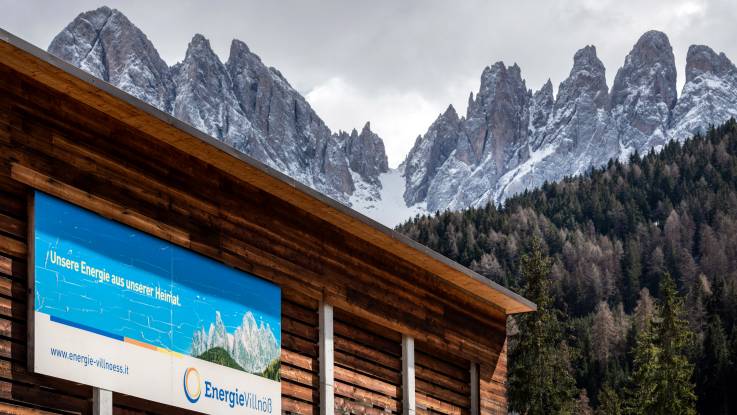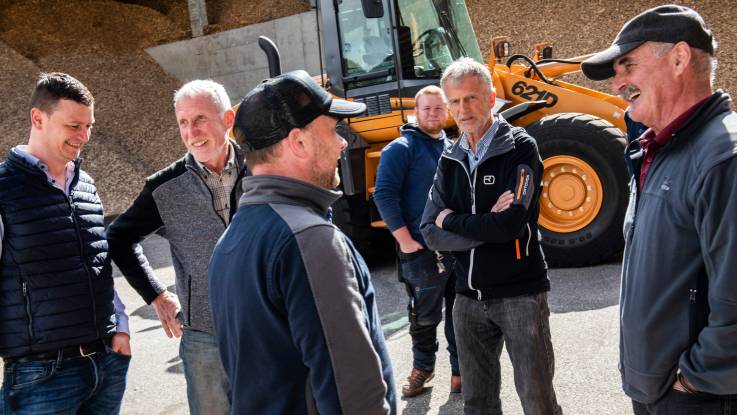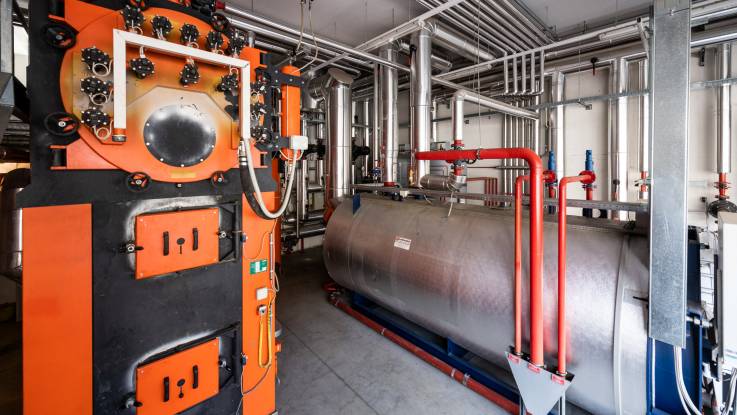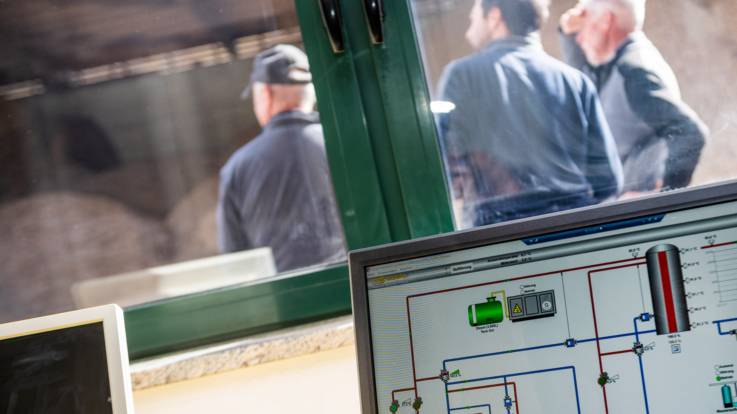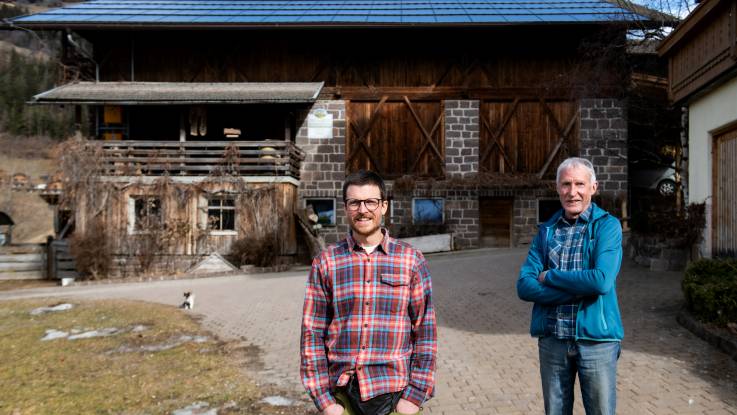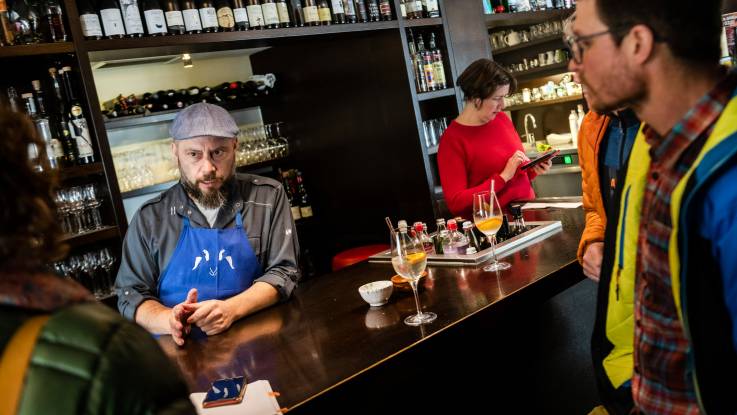Villnöss – Energy from the community
A report by Lucia de Paulis
Fuelled by a cooperative spirit: How a small region in the Dolomites has been successfully meeting its own energy requirements for more than 100 years.
As we leave Klausen in the Eisack Valley of South Tyrol, the road squeezes through a narrow gorge and moss-covered cliffs rise up on either side. Earlier, on the Brenner Autobahn, we were driving past hillside vineyards and chestnut forests, with the first buds visible on the trees. But further up, as the rocky gorge opens out into the valley of Villnöss, with the jagged peaks of the Odle mountains towering behind it, winter returns. Heaps of snow line the road, and every few kilometres we pass house-high piles of wood stacked neatly on the bare fields. The villages and hamlets that make up the municipality of Villnöss are named after saints, and the same surnames appear time and again on the shopfronts. It’s as though passing through the rocky gorge has not only taken us to a different season but to a different time: the usual countless hotels and rows of ski hire points and souvenir shops have been replaced by rustic farms and centuries-old houses with weathered wooden façades. One thing is clear: Villnöss certainly took a different path to its neighbouring Dolomite communities.
Our energy, from our home
The road continues to climb, but we are still surrounded by meadows and forests – not a gondola or chairlift in sight. The hamlet of St. Magdalena sits at an altitude of almost 1,300 metres above sea level and has the only T-bar lift in the valley. Directly opposite stands an inconspicuous flat-roofed building that might be mistaken for a barn were it not for the white steam rising from the chimney. The Odle mountains provide an impressive backdrop to the scene. On the wooden façade of the building is a sign in German that reads: "Our energy, from our home – Energie Villnöss".
This unremarkable structure is one of two state-of-the-art district heating plants in Villnöss. And while “our energy” may sound like an empty advertising slogan, we quickly realise in our conversations with local people that it is accurate. Almost a third of the 2,500 inhabitants are members of local energy cooperative Energie Villnöss – an initiative that has always been about more than just energy production: it has strengthened the local economy and has helped shape the development of the valley and the identity of its inhabitants. When the people of Villnöss talk about energy, the most commonly used pronoun is “we”.
Sticking together – through good times and bad
The Villnöss energy cooperative is one of the oldest in South Tyrol. In 1921, three local farmers and a craftsman founded an electrical company in St. Magdalena with a church loan of 15,000 Italian lire. The company’s founding charter declared its intention “to generate and sell electrical energy in order to provide members with lighting and power and to boost the economy”. The promotion of local craft trades and industry is part of that.
The promissory note for the loan stipulated an interest rate of 4.5 percent and held the debtors personally liable, with all their private property as security. Work quickly commenced, and in 1922 – a little under a year after construction began – the first of the now three cooperative-owned hydropower plants went into operation in St. Magdalena. Support from the locals promptly grew, and with that the number of members and the bond this common cause created. When the cooperative found itself on the verge of bankruptcy in 1929 during the global economic crisis, the farmers once again put up their property as collateral.
The loyalty shown by the people of Villnöss to their energy cooperative makes particular sense when seen within its historical context. After the First World War, South Tyrol was annexed to Italy. From 1922, years of fascist “Italianisation” of linguistic minorities began. German was banned from being taught or spoken in public; German associations and traditions were shut down; German-language newspapers were censored; and German names – both of places and people – were forcibly translated. In light of this past, the German-language slogan “Our energy, from our home” is even more impactful.
Boosting the economy with hydropower

“The people of Villnöss have always been happy to take matters into their own hands,” says Hannes Messner with a smile, as if it were no surprise that the community brought electricity to the entire valley a century ago, on its own initiative and using private funds. Messner – a 42-year-old with a friendly, youthful face – grew up on a farm in the valley. He joined Energie Villnöss in 2010, and has now been managing director of the cooperative for three years. He takes us way back in time to help us understand the history of the cooperative. In the 1930s, he says, the Italian government was primarily concerned with the electrification of industrial areas. Mountain valleys like this one – as well as other remote regions of the country – were regarded as unimportant from an economic standpoint; they would simply have to wait longer for the arrival of electricity. The people of Villnöss refused to accept this. “Thanks to the work of the cooperative, by the 1940s we were already generating enough electricity for our mills, sawmills, craft trades and citizens – and this at a time when people elsewhere were still gathering by candlelight,” explains Messner. “Before that, there were no paved roads in Villnöss and the mills in the valley were powered by the stream.”
From communal electricity to communal heat
So Villnöss now had plenty of electricity, but individuals were still responsible for their own heating. That changed in 2007 and 2008, when two wood-burning heating plants were built to create a district heating network. When the locals were surveyed as to who they thought should operate those plants – the cooperative or the municipal government – the response was unanimous: the heating grid should also be in the hands of the energy cooperative.
Today, Villnöss is an impressive example of successful decentralised, community-based energy production.
Construction of the combined heat and power plants revolutionised household heating in the valley. Today, 97 percent of the buildings in the villages of St. Magdalena and St. Peter are connected to the network. This also benefits the inhabitants financially, as electricity and heating prices have remained stable here for more than ten years. After all, the fuel for the heating plants comes from the valley, and electricity is generated by water. “Even in 2022 when energy prices exploded everywhere else, ours remained 70 percent lower on average – despite the fact that a lack of snow and rainfall the previous year meant that the amount of our hydropower-generated electricity dropped by a third,” explains Messner.
The cooperative can offer such stable electricity prices because Villnöss produces an average of 15 million kilowatt hours per year and consumes only six million of that itself. In the summer months, it sells its surplus electricity; only in the winter does the municipality sometimes have to purchase electricity to cover its needs. “Today we are a virtually self-sufficient energy oasis – successfully decentralised, climate-friendly and citizen-led,” says Messner with pride. “Even our Alpine huts at altitudes of up to 2,300 metres are now supplied with electricity and fibre optics. And we have achieved all of this ourselves, without any public subsidies.”
District heating from local biomass
In front of the St. Peter heating plant, a loader dumps great loads of fresh woodchips into the fuel bunker. The sweet smell of pinewood fills the air and makes it feel like we’re standing in the middle of a forest. “Unlike other heating plants, we have very short transport distances,” says Messner, giving us a tour of the facility. “We supply only a few households and cover our needs entirely with locally grown trees. That means we can guarantee Villnöss farmers a long-term fixed purchase price for their wood.”
During the tour, Messner frequently checks his watch; he’s under time pressure. The Villnöss energy cooperative has only six employees besides Messner: one admin staff member and five technicians. This small team manages the entire supply of electricity and heat to the valley. Working in shifts, they take care of customer service – on site and via their hotline – 365 days a year.
It is practically impossible for us to cope with the regulatory requirements.
A few years ago, the Italian regulatory authorities began requiring thermal power plants to submit regular reports on their emissions and production data. “These regulations were created for the large district heating plants in northern Italy, but they also apply to small cooperative plants like ours. The administrative effort this requires is practically impossible for us to cope with – we would need three or four more people to stay on top of it,” says Messner.
“In any case, our readings are usually better than required and certainly better than those of the large district heating plants,” Messner explains. “It’s keeping up with the communication that is the issue,” he adds, as he opens the door to the boiler room. Inside, it is pleasantly warm. A yellow glow flickers behind a thick glass pane that provides a view of a ceiling-high boiler. In here, the wood chips are burned at 900°C, heating the water in the tank above.
District heating: greater convenience and lower emissions
Pumps transport the 90°C water through underground pipes, distributing thermal energy to those buildings in the surrounding area that are connected to the system. There, the hot water is fed into the respective heating and water circuits. After use, the cooled water is returned to the district heating plant and the cycle starts all over again.
In addition to generating heat, the plant offers major environmental benefits, as the exhaust gases from the chimney of the district heating plant are specially filtered and emissions levels are strictly regulated. Plus, this one central boiler replaces the work previously done by hundreds of separate – often outdated – wood, gas and oil burners, and this has had a great impact on air quality. In a 2011 study, the European Academy Bozen/Bolzano (EURAC) reported that since the commissioning of district heating plants throughout South Tyrol, particulate pollution in the province has fallen by 90 percent.
Heating networks: a model for other regions?
District heating clearly has many advantages – but is it a sustainable solution that can be used on a larger scale? We put this question to Thomas Egger, an energy and environmental engineer who co-founded Klima Club Südtirol (Climate Club South Tyrol) in 2021. He told us: “District heating certainly makes sense as a local solution, especially when there is so much damaged wood available, as is the case right now as a result of storm damage and bark beetle infestations. But it would be a very problematic development if large district heating plants that currently run on gas – such as the one in Merano – decided to convert to wood, as there is also not a limitless supply of wood in South Tyrol.” It would be better, says Egger, for district heating plants to adapt as best as possible to a range of alternative energy sources.
But they do not have the luxury of time: the South Tyrolean government’s climate and energy plan aims to make the province climate-neutral by 2040 at the latest – partly by banning the installation of any new fossil-fuel heating systems from 2023 onwards. “That’s a good start,” says Egger, “but 80,000 heating facilities are still currently running on fossil fuels that all need to be replaced by renewable heating systems in the next 17 years.” A small proportion of those will connect to district heating systems, he explains, but the majority will be replaced by heat pumps. “The electricity for these heat pumps needs to be generated by photovoltaic systems, as we have almost exhausted our hydroelectric potential in South Tyrol,” Egger adds, emphasising the need for targeted, massive expansion of photovoltaics in the province.
A climate plan with flaws
Egger believes that the solar expansion measures outlined in South Tyrol’s 2040 climate plan fall far too short: “Currently, the PV systems installed in the province have a total capacity of 280 megawatts. But according to our calculations we need at least six times that amount to become climate-neutral by 2040.” So back in 2021, the Klima Club made a recommendation to the South Tyrolean government that, in addition to installing solar panels on buildings and in open spaces, it should focus on the expansion of agrivoltaics. For instance, compact PV modules could be mounted on the struts holding up anti-hail nets in some of South Tyrol’s apple orchards.
In view of the climate crisis, we can no longer afford to put aesthetic concerns first.
“If we assume that 1,250 megawatts of PV power is installed on buildings by 2045, that leaves around 550 megawatts that will probably need to be generated through agrivoltaics,” explains Egger. He estimates that this would require an area of around 1,100 hectares – less than ten percent of the land currently used for apple cultivation. Implementing agrivoltaic solutions would therefore have a minimal impact on income from food cultivation – and would in fact be more lucrative for the plots where the systems are installed. “Yes, these PV modules would alter the appearance of our landscape,” Egger admits. “But in view of the climate crisis, we can no longer afford to put aesthetic concerns first.”
Calls for decentralised energy management
Rudi Rienzner is managing director of the South Tyrolean energy association SEV, which represents the political interests of energy cooperatives and offers sector-specific services like the purchase and sale of electricity – precisely what small cooperatives like the one in Villnöss have trouble managing. Rienzner – a grey-bearded 65-year-old – is an old hand in the energy business, having already managed the public utility companies in Brixen and Verona. “For years, the SEV has been calling for energy management to be shared between associations, municipalities and cooperatives,” he says. “The successful promotion of district heating in the 1990s showed that involving the community and creating cooperatives is the right way to go. Energy policymakers today should remember that.”
Local energy management strengthens local supply chains.
Rienzner explains that decentralised energy production management could reduce electricity costs for consumers by ten to 20 percent. “And those savings may encourage involvement by people who are not convinced by the environmental argument,” he adds. He also emphasises that local energy management strengthens local supply chains, citing another study by EURAC that showed that 70 cents of every euro paid by consumers in South Tyrol for locally produced electricity and district heating stay in the local community.
The valley’s lucky break
Next, we pay a visit to Paul Profanter, former managing director of the Villnöss energy cooperative. He now runs the long-standing organic farm Ganoi, which was first mentioned in a document in 1277. The farm is perched on a hill close to St. Peter and affords a breathtaking panoramic view of snow-covered mountaintops and vast expanses of Alpine meadows. Anywhere else, this sort of view would probably be enjoyed from the infinity pool of a massive spa hotel. But here, the pastures are reserved for the Tyrol Grey cattle, who gaze at us in curiosity. Profanter – an athletic 71-year-old with a weather-beaten face – radiates the calm of an experienced mountain guide. He sees the Villnöss valley as a good example of how local, citizen-based energy management has strengthened the economy and had a positive impact on the community and its residents. “Villnöss has always had good soil for growing grain – and early electrification by the cooperative helped agriculture in the valley get up and running a long time ago. That was our lucky break,” says Profanter.
He also sees the conscious rejection of ski tourism in the Villnöss valley as a sign of a strong, self-determined community: “We rely on a well-balanced relationship between agriculture and nature-based tourism,” he explains. “When ski tourism began to boom elsewhere, we already had a strong economy thanks to the cooperative and could therefore afford not to get involved. For us, the energy cooperative has never been solely about economic progress – it is also about jointly taking matters into our own hands in a way that benefits everyone.”
We have achieved a great deal together.
When we ask Profanter about his more than 40 years as managing director of the cooperative, he does not boast about his personal successes – instead, like so many people here, he lapses into the collective “we” and straightens up slightly, as if physically bolstered by thoughts of the community: “We have achieved a great deal together – we built three hydroelectric power plants and two district heating plants, we even supplied the mountain huts with electricity and fibre optics. Villnöss is now a shining example of sustainable energy management.”
Forging their own path together
A few meadows away at Pitzock, a restaurant in St. Peter, a few Villnöss residents are standing at the bar enjoying an aperitif as the sound of clanging pots and pans comes from the kitchen. In a glass cabinet, an award from the Gault & Millau restaurant guide and reviews from gourmet food magazines are positioned next to traditional woollen hats and photos of traditional Tyrolean wool jackets. The chef and owner is Oskar Messner – also a member of the cooperative, of course. In 2011, he had the idea of transforming this former village tavern into a Slow Food restaurant that sources its ingredients from as many local producers as possible. This idea strengthened the local economy and quickly proved itself a successful business model – in 2022, Villnöss became the first recognised Slow Food Travel destination in the entire region of Trentino-South Tyrol.
When we ask him about the energy cooperative, Messner says: “The people of Villnöss have always forged their own path. We are all quite headstrong and we have a pioneering spirit – which definitely originates from our history.” With a smile, he tells us an anecdote about a Russian businessman from the Caucasus who came to South Tyrol in 2014 to find out about local Alpine farming. “He also came to Villnöss and a group of residents, including myself, showed him around. When he asked about our gas consumption, Paul Profanter replied: ‘Gas? Oh no, we don’t need that here!’” At this point in the story, Messner proudly emphasises the “we” – once again making it clear that the cooperative has not only transformed Villnöss into a self-sufficient energy oasis and boosted the local economy, it has fostered a community spirit in the valley that is just as strong and sustainable as its energy production.
Translated from the German by Grace Winter / Babelfisch Translations. You can also read the report in German.
Lead photo: Ivo Corà
Related stories
-

Croatia goes over to the sunny side
Despite its enormous potential, solar energy has yet to get off the ground in Croatia. A green energy cooperative called ZEZ wants to change that.
-

Winds of Change on Samsø Island
The Danish island of Samsø produces more energy than it consumes. A dynamic couple and a dedicated community are the secret of its success.
